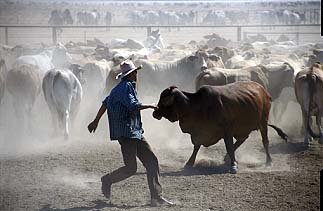Recently I judged a local shows commercial and stud cattle sections. I really enjoyed the chance to look at a range of cattle and to provide some comments about the animals I assessed. However on reading through the report of my judging in one of the major rural papers, I’m not sure my comments were heard as clearly as I thought I had made them!
If you believe the report, my judging was influenced as much by the recent hot, dry summer as anything else. This had apparently caused my to lean more towards Bos Indicus cattle than British breeds. Well if only it was that simple!
I can confidently say that weather doesn’t influence my judging or indeed change the criteria have in my mind for cattle! Climate and environment or the other hand, do play a role. I think a lot about suitability of a breed to an environment. But its not the first thing I think of!
I assess cattle for three key attributes. The first is that they must be structurally sound. When I talk about structure I am referring to the skeletal system of the animal; as well as other physical traits.
So first off, I look at the way the animal walks. If an animal can place its feet in line with each other, with no over stepping or under stepping by the hind feet, then I start to feel the structure of the legs, hips, and shoulders are acceptable. I then like to look at how the animal stands, and I have another look at the angel of the shoulders, and the way it stands with its hind feet and legs in a normal standing position.
Its then that I have a chance to decide if the animal is standing too low on its hind feet, or two high. Both of these are a result of legs that are either curved or too straight, and its something I may not have noticed when I was watching it walk. I also want to see if the hocks are bowed in outwards or inwards.
What I really want to determine is how sound is the animals feet legs and shoulders? Can it walk a long distance each day to graze and water, and will it be able to carry the weight of its body without causing it to have sore joints that could lead to swelling, lameness or arthritis.
I reckon these traits are important for the longevity of animals within your herd and contribute directly to your overall profitability. If you have cows that can conceive, calve and wean a calf every year that is the first part of profit. The second is to have cows that can do this up to 10 years old.
When I run the figures on herd profits, those that have cows that are fertile and staying in the herd because they can get about, look after themselves and a calf have a higher profit margin. That’s often because they are selling a few more surplus heifers, and the heifers they do retain for breeding are the select group of genetically and physically better heifers.
As part of my structural assessment I look closely at teats and the udder to make sure that the quarters are all even and the teats are well shaped to support a calf sucking. I also want to see that all four teats can be used and not left un-milked as this can contribute to mastitis, which is pretty painful for a cow and will result in lower productivity.
When I’m happy with structure I look for the traits that add to productivity and profitability. We are breeding cattle to produce red meat, so I will always select for muscle. I look at the shape of the animals, the width depth and length of each animal to determine its overall muscle volume. You can have muscle in females, and it wont reduce your fertility. So I select for it.
I also like to think about maturity pattern and frame size. Large frame later maturity females will naturally require more feed to achieve their body requirements for maintenance, let alone for reproduction and growth. Remember you can only grow so much pasture or put out so many supplements.
And if you want your animals to do well, you need to feed them properly. Large frame later maturity animals may mean you run less numbers in your herd, and so may impact on the total number of kilograms of beef you produce each year.
Whenever I assess cattle, temperament is my other key trait. I like cattle to have a quiet temperament. Aggressive or overly excitable cattle are both dangerous and less productive; due to the impact temperament has on eating quality.
Ideally, my preferred animals are those that are structurally sound, well grown, well-muscled females. I prefer them to be moderate maturity and quiet temperament.
Ultimately I prefer them to suit the country and environment and to suit their target markets in both size and breed.
If I can help my clients have a breeding herd like that, I’m very happy. And when I’m judging I’ll always try and select those females first, regardless of the weather on the day!








